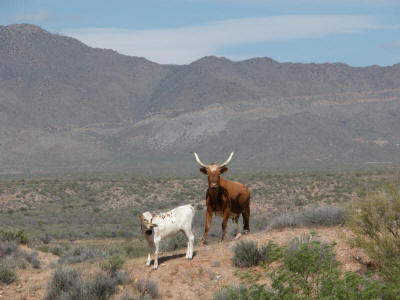 Cowboys and Cattle Trails
Cowboys and Cattle Trails
 Cowboys and Cattle Trails
Cowboys and Cattle Trails
After the close of the Civil War in 1865, the greatest economic asset of Texas rested in vast herds of longhorn cattle. The Texas Longhorn was tough, cunning and mean. He was on his own from the minute he was born, and after living several years in the brush, he did not take kindly to being roped, hog-tied, branded and thereafter held in a loose herd until the cattle drive got underway. These Texas cattle had lanky bodies, with long legs and feet built for speed. It took a good horse with a good rider to outrun a Texas Longhorn. Their narrow faces, sullen expressions, and horns that swept out horizontally, gave these cattle a sinister look. And indeed, they could be mean. A century or so of running wild had make the longhorns tough and hardy enough to withstand blizzards, droughts, dust storms, attacks by other animals, and Indians. They did not require great amounts of water to survive and were well-equipped for the long trail. They usually lost very little weight on the drive. Their horns served for attack and defense. A strong sense of smell made it easy for the cow to find her calf and she would ferociously defend this calf.
And the bulls... There was probably no meaner creature in Texas than a Longhorn bull. The slightest provocation would turn him into an aggressive and dangerous enemy. The bull's horns usually measured six feet or less from tip-to-tip, but could measure over eight feet. In addition, the sharpness of horns of any length, the speed and muscle power of the bull, and the ease with which he could be aroused and enraged, made him a dangerous and uncontrollable animal. When two bulls met, there was sure to be a fight, often to death. And only a very well-armed cowboy had a chance against a Longhorn bull.
The abundance of cattle at the end of the Civil War had depressed the Texas market. However, the prices of cattle and beef were still high in the North and East. Locally, a longhorn was worth about $3 to $5, but in the cities of the North and East, the same steer would sell for $35 to $40. So despite the danger involved in a round-up, the hardy Texas cattle began flowing north.
Ranching started in Texas, and it soon turned the Great Plains into a vast cattle empire. Texans began driving their herds through Indian Territory, the land of the great cattle trails between 1866 and 1889, to shipping points in Missouri and Kansas. The cowboys followed the Chisholm Trail, the Western Trail, Loving-Goodnight, Dodge City and other cattle trails north. Herds of livestock soon rumbled into Kansas cattle towns As cattle drives crossed the Indian Territory plains, drovers recognized the value of Oklahoma's land for grazing, and the economical advantages of originating a herd in the territory. Oklahoma eventually turned into a prime site for cattle ranches and continues to be a thriving center for livestock.
Cattle herds traveled the trails through what was to become western Oklahoma until 1892 when homesteaders located and began fencing Oklahoma Territory. Local lore and history tells about the Great Western Trail traversing this area with it's origin at Bandera, Texas, just to the NW of San Antonio, about 450 miles south of the Red River, and it's destination of Dodge City, Kansas, about 45 miles north of Indian Territory. Some historians called the trail the old Doan Trail, because it crossed the Red River at Doan's crossing. This trail is also known as the Old Texas Trail, or the Old Dodge City Trail.
Doan's Crossing was a short distance from Doan's Store, which was the last supply station for those traveling to Kansas by way of the Indian Nation. C. E. Doan kept a perfect record of the herds crossing. 1881 was the peak of the cattle herds with 301,000 head driven through. He kept the name of the Trail Bosses, the number of cattle, and who they belonged to. One of the largest was the King Ranch, shipping 30,000 head divided into 10 herds in a single season.
During the last half of the 1800's, nearly 10 million longhorn cattle were driven north from Texas by 30,000 cowboys. Most of these trail drives passed through Oklahoma Indian Territory and New Mexico on the way to market railheads in Kansas, Missouri, Colorado and Wyoming; other trail drives went east into Louisiana. Well-known trail names such as Goodnight-Loving, Chisholm, Shawnee, Ellsworth, Dodge, and Sedalia were as much a part of history as the legends and true stories of Indian attacks, wild frontier towns, rustlers and famous gunfighters. The trail drives typify the endurance of the longhorn and the perseverance of the rancher and the cowboy who defied the odds, faced the hardships and helped build the great American cattle industry.
Source:
e-MAG Texas; "Texas Longhorns: A hostory of longhorn cattle and guide to viewing the State of Texas' longhorn herd"
Source:
Ethel Taylor grants that this information and data may be used by non-commercial entities, as long as this message remains on all copied material, for personal and genealogical research. These electronic pages cannot be reproduced in any format for profit, can not be copied over to other sites, linked to, or other presentation without written permission of Ethel Taylor.
Source:
The Texas Longhorn Reference Library, a part of the Texas Longhorn Showcase, http://longhornshowcase.com/Library/.